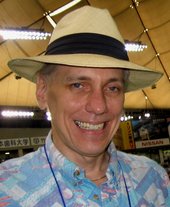
THE HOT CORNER: At what cost mound excellence?

THE HOT CORNER: At what cost mound excellence?
by Jim Allen (Jan 6, 2011)
The pursuit of excellence through extreme practice is in some ways the essence of Japan's game.
Excellence always comes at a cost, and it's not always just time and energy. Sometimes, the unbridled pursuit of excellence results in injury-aborted careers.
Such was the case for Nariyuki Fujii, a promising hard-throwing lefty, whose dream of playing at Koshien Stadium was short-circuited by shoulder injury.
"I really wanted to play at Koshien," the Ibaraki Prefecture native told The Hot Corner last week. "I was thinking of four [Ibaraki] schools. A couple of big left-handed pitchers had come out of Hokota Ichiko, so I thought, 'That's the place to go.'"
Fujii, now 46, moved away to live at Hokota's baseball dormitory and practiced hard with the goal of becoming the school's left-handed ace.
"The plan was for the first-year players to just build up their physical strength," he said. "I didn't expect a chance to pitch in real games until I was in my third year, but before long our top senior lefty and our top sophomore lefty both suffered arm trouble and I started picking up the pace in practice."
When Hokota was knocked out of the prefectural tournament, Fujii began competing for the following year's squad.
"One evening, after pitching in three straight practice games, I was talking with teammates about pitching," Fujii said. "When I tried to mimic my delivery, I felt pain. Something was wrong.
"That day I had thrown seven innings. It was raining and I had to adjust for the conditions. I pitched so much because I wanted to make the team. I was tired and my mechanics were probably off."
Fujii rested a few days but it didn't help, nor did trips to the doctor or acupuncturist. While waiting for his shoulder to recover, he dedicated himself to building up his lower body through running, and developed leg trouble in the process.
Searching for answers, Fujii found a book on scientific training methods from the United States that explained how to train while avoiding injury. The book advised against running on asphalt--as he and his teammates did--and suggested players adopt different training programs to deal with specific needs.
"It made a lot of sense to me," Fujii said. "Why should everyone practice exactly the same way? I showed the book to the manager, but he said, 'That's not our way. We all practice the same way here.'"
Fujii's shoulder never completely recovered. His efforts to find a pain-free delivery produced pitches with no movement on them, and he was relegated to support duties: throwing batting practice and picking up baseballs.
"One day, I was throwing batting practice...and everyone around me could see I was in pain," Fujii said.
"The coach, on the other hand, said I felt pain because I lacked guts."
In his senior year on the sidelines, Hokota won the prefectural tournament and advanced to the national summer championship at Koshien behind right-hander Kiyokazu Seki, later a Toyo University star and the Lotte Orions' first-round draft pick in 1986.
"So many times I did nagekomi [marathon bullpen sessions] alongside Seki," Fujii said. "He was the big right-hander and I was the big lefty. We would both throw 300-pitch bullpens. After 200 pitches, my legs would be wobbling and I was throwing entirely with my upper body. Seki could throw 300 and look like he could throw another 100.
"His strength and his mechanics were good enough, mine weren't. The manager never told us to throw 300 pitches at a time. He just said 'practice.' And during summer vacation, that's what we did. We did it because we wanted to get better."
Ryuichi Shimizu, of Tokyo's Caliper Coaching College, said it's hard for Japanese coaches to set limits on practice.
"In America, they can say, '100 pitches' and people will obey," Shimizu said Tuesday. "Here, even if you set limits, people will just do what they want. Every pitcher wants to get better and better, and so every pitcher throws more and more."
Shimizu said, however, that the thinking has changed dramatically in the past decade or so.
"Coaches are much more open to scientific methods," he said. "Now, we're more willing to listen."
To access the original work (if still available), please reference:
http://www.yomiuri.co.jp/dy/sports/T110105003643.htm.
Back to the works of Jim Allen
This work is licensed under a Creative Commons License.
Some rights reserved.
